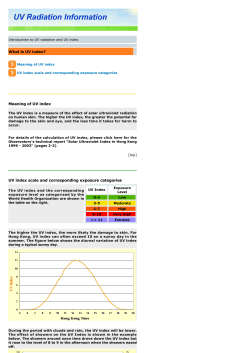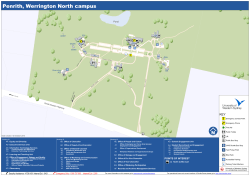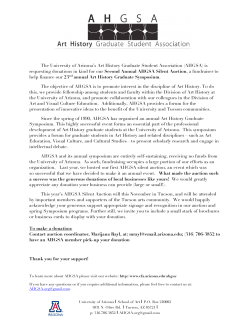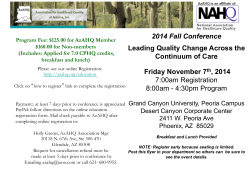
vatican observatory embracing, encouraging and promoting scientific study Spring 2014
vatican observatory N E W S L E T T E R Spring 2014 embracing, encouraging and promoting scientific study Angels in the Dome Photo by Ryan Ferguson of Flyback Productions Father José Funes, S.J. Director, Vatican Observatory her conviction that ‘faith and reason are like two wings on which the human spirit rises to the contemplation of truth’ (Fides et Ratio, Proemium). Father Albert J. DiUlio, S.J. For more information, email (info@vaticanobservatory.org) or call (+1 (520) 795-5314). President, Vatican Observatory Foundation Founded in 1891, the Vatican Observatory demonstrates the Church’s desire to embrace, encourage and promote scientific study, on the basis of vatican observatory A Departing Message from the President by Fr. Albert DiUlio, S.J. Springtime in Tucson is here….the good news is that we had no winter and the scientists are busy with observation and planning for the future. As always, our lives move with the rhythm of the universe and that in itself defines our Sacred Space. The rhythm of the Vatican Observatory Foundation also directs our lives and now is to be a time of transition. I will be concluding my time as President in August and Br. Guy Consolmagno, S.J. will be taking the helm of this marvelous organization. Br. Guy comes to the Foundation from the Vatican Observatory in Rome. Guy is returning to Tucson where he did his graduate work in astrophysics at the University here and is an acclaimed speaker and accomplished scientist who specializes in meteorites and their composition. Please welcome him into our community and lives. The current major project for the Vatican Advanced Technology Telescope (VATT) is the full robotization of its operation. This will be done in conjunction with the University of Arizona and will include three telescopes: VATT and two telescopes of the University of Arizona. This project will take several years to complete but will result in far greater accessibility for scientist and educators. Robotization will allow scientists and educators from around the world to utilize this outstanding instrument without having to come to Tucson and ascend Mt. Graham. This project ensures the viability of the VATT for many years and will allow it to continue as a prime telescope for astronomical observations. Please let me take this opportunity to thank you for a wonderful three years as President of the Vatican Observatory Foundation. They have been exciting years and years that have seen great progress in the work, projects and efforts of the Foundation. Br. Guy brings a fresh perspective, one of a scientist, that will continue to move the Foundation forward and into the next phase of its mission to ‘go to the frontiers’ as so ably recommended by Pope Benedict XVI. Blessings and all best wishes. Br. Guy Consolmagno, S.J. We Welcome Two New Members to the Vatican Observatory Foundation Board: Roger Gamache is the founder and president of Gamache & Associates, a financial advisory practice of Ameriprise Financial, in Holland, Michigan. No stranger to the Jesuits, he graduated from the University of Detroit High School and Georgetown University. He is active in a number of charities in the Holland area, including serving on the boards of the Holland Community Hospital and the Macatawa Junior Association. He is an avid sailor, and is a past commodore of the Macatawa Bay Yacht Club. Spring 2014 Nancy Lebofsky is a noted expert in astronomy education and outreach, especially at the K-12 levels. She has worked for many years in astronomy outreach at the University of Arizona, including five years as coeditor of Meteorite! magazine, and most recently as part of the NASA-funded education program for Steward Observatory's near-Infrared camera slated to be flown on the upcoming Webb Space Telescope. She is also an instructor at the Astronomy Camp for Girl Scout Trainers. In honor of her contributions to public understanding of solar system objects, the IAU has named asteroid 5052 Nancyruth in her honor. 2 Reaching for the Heavens The Apostolic Nuncio visits the Vatican Observatory in Arizona by José Funes, S.J. We were honored and very pleased with the visit of Archbishop Carlo Maria Viganò, Apostolic Nuncio of the Holy See to the United States, who was in Tucson at the beginning of March. Archbishop Viganò was well acquainted with the Vatican Observatory since he was General Secretary of the Governatorate of the Vatican City State from 2009 through 2011. On March 3rd Archbishop Viganò met with the Jesuit astronomers, the technical staff responsible for the development of the Vatican telescope and with faculty of the Steward Observatory. He also visited the Steward Observatory Mirror Lab where Prof. Buell Jannuzi, Director of the Steward Observatory, and Prof. Roger Angel offered a tour of the facilities. In the evening a reception and dinner were held in honor of Archbishop Viganò. Bishop Gerald Kicanas, authorities of the University of Arizona, directors of the Observatories in Southern Arizona and benefactors of the Vatican Observatory Foundation joined the Jesuit astronomers on this happy occasion. In his address Archbishop Viganò pointed out: “In many ways, as we see here from this Observatory, science and technology, when applied correctly, can help deepen our faith. It can help us fulfill our role in being a more adoring people, to recognize our dependency upon that which is beyond us. It is an unending journey and a liberating experience which must be carried out with complete respect and freedom of the human person... We are in a state of constant discovery of the Truth, so ever present and so much beyond ourselves. This discovery frees us and makes us so fully alive. How blest we are to be part of all this. May your invaluable mission for the Church and for all humanity continue to prosper and bear much fruit”. Apostolic Nuncio to the United States, Archbishop Carlo Maria Viganò and Bishop Gerald Kicanas of Tucson with Vatican Observatory Members. Left to right: Fr. David Brown, S.J., Fr. Albert DiUlio, S.J., Bishop Kicanas, Archbishop Viganò, Fr. Jose Funes, S.J., Fr. Joseph Maj, S.J., Fr. Chris Corbally, S.J., Fr. Richard Boyle, S.J., and Br. Guy Consolmagno, S.J. Archbishop Viganò with Vatican Observatory Benefactor Rose Cracchiolo Collins. Rose Collins shows Bishop Kicanas her photos taken with Pope Francis. The following day Archbishop Viganò accompanied by Father Funes and Father Corbally visited the VATT and the LBT at the Mount Graham International Observatory. Dr. Christian Veillet, director of the LBT, showed the impressive giant LBT in motion. We are very grateful to Archbishop Viganò for accepting my invitation to share with us two wonderful days in Southern Arizona. 3 Spring 2014 vatican observatory Annual Seminar Hosted at Steward Observatory On February 20th the Director of Steward Observatory, Dr. Buell Jannuzi, kindly hosted and participated in the Annual Seminar of the Vatican Observatory on the University of Arizona campus. He also promoted the event through the university channel. Similarly Bishop Gerald Kicanas of the Diocese of Tucson announced our gathering to his parishes thus bringing together over 150 scientists, educators, students and local Catholics, the largest group ever to attend this event. Our thanks and appreciation go to the Jesuit Community of the Vatican Observatory for the very generous grants in both 2013 and 2014 to help defray the costs of the seminars. A podcast of the presentations has been made available and posted on the website of the University of Arizona through, again, the generous collaboration of Steward Observatory. Rev. Jose’ G. Funes, S.J. Director, Vatican Observatory “To the Edge of the Universe” Tony Witteman and Dr. Brenda Frye enjoy the seminar reception. Dr. Buell T. Jannuzi Director, Steward Observatory and Head, Department of Astronomy “A New Steward Observatory Collaboration with the Vatican Observatory: The Arizona Robotic Telescope Network” Br. Guy Consolmagno, S.J. Vatican Observatory, Curator of the Vatican Observatory Meteorite Collection “The Chelyubinsk Fireball, One Year Later” Rev. Jean-Baptiste Kikwaya, S.J. Vatican Observatory “Observing NEOs and Meteors” Spring 2014 4 Reaching for the Heavens 2014 Annual Circles of Giving Dinner and Award Ceremony In Tucson in February friends and colleagues gathered for the Circles of Giving Awards Dinner to honor lifetimes of support for the Vatican Observatory. This public recognition is only a small token of our profound gratitude and appreciation. Our many thanks and prayers go to all this year’s honorees. They are: Gregory XIII Circle - $250,000 The Dan Murphy Foundation Pius XI Circle - $100,000 Jim and Diane McGee Angelo Secchi Circle - $50,000 Paula and Oscar D’Angelo The Hearst Foundation The Dorothy and Thomas Leavey Foundation Eusebio Kino Circle - $25,000 Donald and Lauren Morel Board Chairman, Rich Friedrich, presents the LeMaitre Award to Andrea Dudek. Fr. DiUlio presents Sid Leach with the Clavius Award. Christoph Clavius Circle – $10,000 Joseph and Patricia Consolmagno Guy and Gisele Di Spigno Rev. James T. Gregory Patrick C. Harbour Sydney and Gloria Leach Pamela Madden Gregory and Linda Maxon Dr. Edward Oleen Georges LeMaitre Circle - $5,000 Andrea Dudek Karen Gardner Michael and Stacey Lent Jerry and Wendy Sullivan Director of Steward Observatory, Dr. Buell Jannuzi, and VOF Board Member, Tony Witteman Keynote Address by Dr. Timothy Swindle Gen. Don Rodgers, Julie and Max Ivey with VOF Board Member, June Scobee Rodgers. 5 Rich Friedrich presents Pam Madden with her Clavius Award. The Vatican Observatory Foundation is pleased to have had as Guest Speaker at this year’s Awards Dinner Timothy D. Swindle, Ph.D., Director of the Lunar and Planetary Laboratory at the University of Arizona. Dr. Swindle presented a fascinating talk on “Hunting asteroids and meteorites, from spacecraft to telescopes to the Antarctic.” Spring 2014 vatican observatory The Search for Life Beyond the Solar System By Fr. Paul Gabor, S.J., Ph.D., Vice-Director, Vatican Observatory The Vatican Observatory and the University of Arizona co-hosted a conference on "The Search for Life beyond the Solar System. Exoplanets, Biosignatures & Instruments" from March 16-21 in Tucson, Arizona, home of the Vatican Observatory’s major research infrastructure, the VATT, a 1.8-m telescope on Mt Graham. The conference was a demonstration of the close and fruitful collaboration between the University of Arizona and the Vatican Observatory, which dates back to 1980. It was the major event of the year in the field in the US and internationally, made all the more important because NASA does not hold its usual biannual Astrobiology Science Conference this year. Astrobiology is an interdisciplinary scientific pursuit of life in the broadest context, of its cosmic abundance, origins, future, and, indeed, its nature. For practical purposes one can say that the term is roughly synonymous with the now less frequent “exobiology”, and coextensive with the term “bioastronomy” preferred by the International Astronomical Union, designating it as a subdomain of astronomy and reflecting the fact that most researchers in the field are astrophysicists. A classical definition by genus and species presupposes the knowledge of a large number of instances of the given genus. With life, we are only aware of one occurrence, making a definition and any generalizations very precarious. In very practical terms, many conjectures have to be made when searching for life without a clear notion of what we are looking for. The current research focuses on four broad areas: (1) Exploring the extreme extent of life on Earth, i.e., the extremophilic organisms, (2) biochemical studies of the origins of life, (3) exploring other Solar System (Mars, Titan, Europa, Enceladus) bodies in situ, and (4) spectroscopic remote study of planets orbiting other stars than the Sun, i.e., extrasolar planets or exoplanets. The conference primarily addressed the latter, which, however, would have been impossible without sharing with researchers mainly working in the first two areas. Recent discoveries are rapidly increasing the number of known Earth-sized planets. Meanwhile, scientists are finding a likewise increasing range of extreme conditions in which life on Earth can persist. But what techniques and technologies will allow us to search for such life on these exoplanets? To address this multifaceted challenge, the 200 scientists attending the conference, shared their expertise on exoplanet observations, early and extreme life on Earth, atmospheric biosignatures, and planet-finding telescopes. One of the main debates in astrobiology is the sequence of steps which would allow us to learn more about life beyond the Solar System. Exoplanets are out of reach of our probes, and the only viable option in the coming decades if not centuries, is remote sensing, spectroscopically analyzing the light reflected, emitted or transmitted by these bodies. Unfortunately, there is a major technical challenge: how to distinguish the exoplanet’s light from the light of its parent star. Several methods are available but still require a lot of work. The conference served the crucial purpose of bringing people together to discuss how best to proceed. And thanks to the conference, a consensus is closer now than it was before. VO’s primary mission is to do good science. Astrobiology and exoplanetology are very dynamic and interesting new fields of research addressing ancient philosophical questions. With the VO Summer School of 2005, and the Pontifical Academy of Sciences Study Week in 2009, the conference is another example of the Vatican’s contribution to the field. Along with the conference itself, students were invited to attend a school the weekend before the conference; 26 participants from 7 countries were slated to attend that school, which was held at the UA Biosphere 2. The school was a pre-conference workshop where the participants (mainly graduate students and junior post-doctoral researchers) attended lectures and tutorials, in order to have the best starting point for the conference. Spring 2014 6 Reaching for the Heavens R e q u i e s c at i n Pac e , Fat he R B i l l Rev. William R. Stoeger, S.J., astronomer at the Vatican Observatory, died March 24, 2014 at the Sacred Heart Jesuit Center in Los Gatos, CA, after a struggle with cancer. He was 70 years old and had been a member of the Society of Jesus for 52 years. He entered the Jesuit Order at Los Gatos in 1961. His studies took him to Spring Hill College, Mobile, UCLA, and Cambridge University, England, where, working with Stephen Hawking and colleagues, he received his Ph.D. in Astrophysics. After postdoctoral work in gravitational physics at the University of Maryland, Bill joined the staff of the Vatican Observatory. Bill’s expertise was theoretical cosmology, highenergy astrophysics and interdisciplinary studies relating science and religion. In addition to being a renowned scientist, Bill was sought after as a retreat presenter and spiritual director. Education: “Astronomy Skits for Secondary School Science Education” Prescott Astronomy Club at the Prescott Public Library Date: October 16, 2014 Fr. Chris Corbally, S.J., and Dr. Margaret Rappaport will describe their upcoming book for science educators and science policy makers, and review the latest, worrisome numbers of science graduates in the United States and worldwide. They will then illustrate the book with a performance of two of their Astronomy Skits, and discuss their purpose of attracting young adults to astronomy and the sciences in general. For other speaking engagements see: http:// margaretrappaport.vpweb.com/Speaking-EventsSchedule.html To read the full obituary please go to: www.vofoundation.org Br. Guy "tours" California and VOF Board Member "observes" Remotely Br. Guy Consolmagno with Faith and Science students and their teacher, Adrian O’Keefe, at St. Ignatius Prep in San Francisco. VOF Board Member, Chris Hitchcock, joins Carl Hergenrother in the Remote Observing Lab at Steward Observatory in Tucson. From here the VATT can be used as if the observer were on the mountain. At the University of San Francisco Br. Guy discussed “The Jesuit Impact on Astronomy” for the series organized by Fr. John Coleman, S.J. on “The Legacy of the Jesuits in Spirituality, Art, Science, Theology and History.” 7 Bannan Institute at Santa Clara University hosts Br. Guy for their series “What Good is God”? His title - “Why Science Needs God”. Credit Grace Ogihara for Santa Clara photos Spring 2014 Non Pro vatican observatory f o u n d a t i o n 2017 East Lee Street Tucson, Arizona 85719 NON PROFIT ORG U.S POSTAGE PAID TUCSON, AZ PERMIT NO. 3341 O Sample 5 specola vaticana V-00120 Città del Vaticano Roma, Italia Indicia Design, Placement, and Content 6.3.1 Production RETURN SERVICE REQUESTED Embossed or unembossed permit imprint indicia may be made by printin plate, or similar device. They may not be typewritten or hand-drawn. [P04 Follow the Vatican Observatory on Twitter @VaticanObserv Like the Vatican Observatory Foundation on Facebook See our new website: 6.3.2 Permit Imprint Indicia Content and Format The content and format of a permit imprint indicia must meet the standar 6.3.3 Indicia Legibility and Color The permit imprint indicia must be legible and of a color that contrasts su different color may be used to highlight the background of an indicia. [P0 6.3.4 Indicia Placement on Mailpiece Permit imprint indicia must be aligned parallel with the address of the ma participant code, delivery point barcode) if such a standard applies and c a. Upper right corner of the mailpiece. b. Upper right corner of the address area. inside c. To the right of the address on an address label. Apostolic Nuncio visits the VATT At the moment we are still developing our ideas for the workshop; the current plans include a daily schedule of time for prayer and sharing, a lecture on some aspect of astronomy, a laboratory session where the participants can get hands-on experience with how science is done, and short field trips to telescopes or planetary labs in the Tucson area. We have no idea yet how many people will apply, or how much scholarship support we will be able to offer. If there are more applicants than spaces, our first priority will be to choose people actively working in parish education. We are especially eager to include those who would be in a position to carry our materials back into their areas and share with people in their parish and diocese the ideas and experiences that come out of the workshop. Details will be posted at our website, www. vofoundation.org at the beginning of September when applications open. Please consider a gift in support of scholarships for this program. d. To the right of the address on an insert appearing through a window Astrobiology and Exoplanetology Faith and Astronomy Workshop Fr. Bill Stoeger January 19 - 23, 2015 Faith and Astronomy Workshop! January 19 - 23, 2015 For parish priests – and those who work with them in youth and adult education Four days of prayer, reflection, and hands-on-astronomy with the scientists of the Vatican Observatory in Tucson, Arizona
© Copyright 2025









